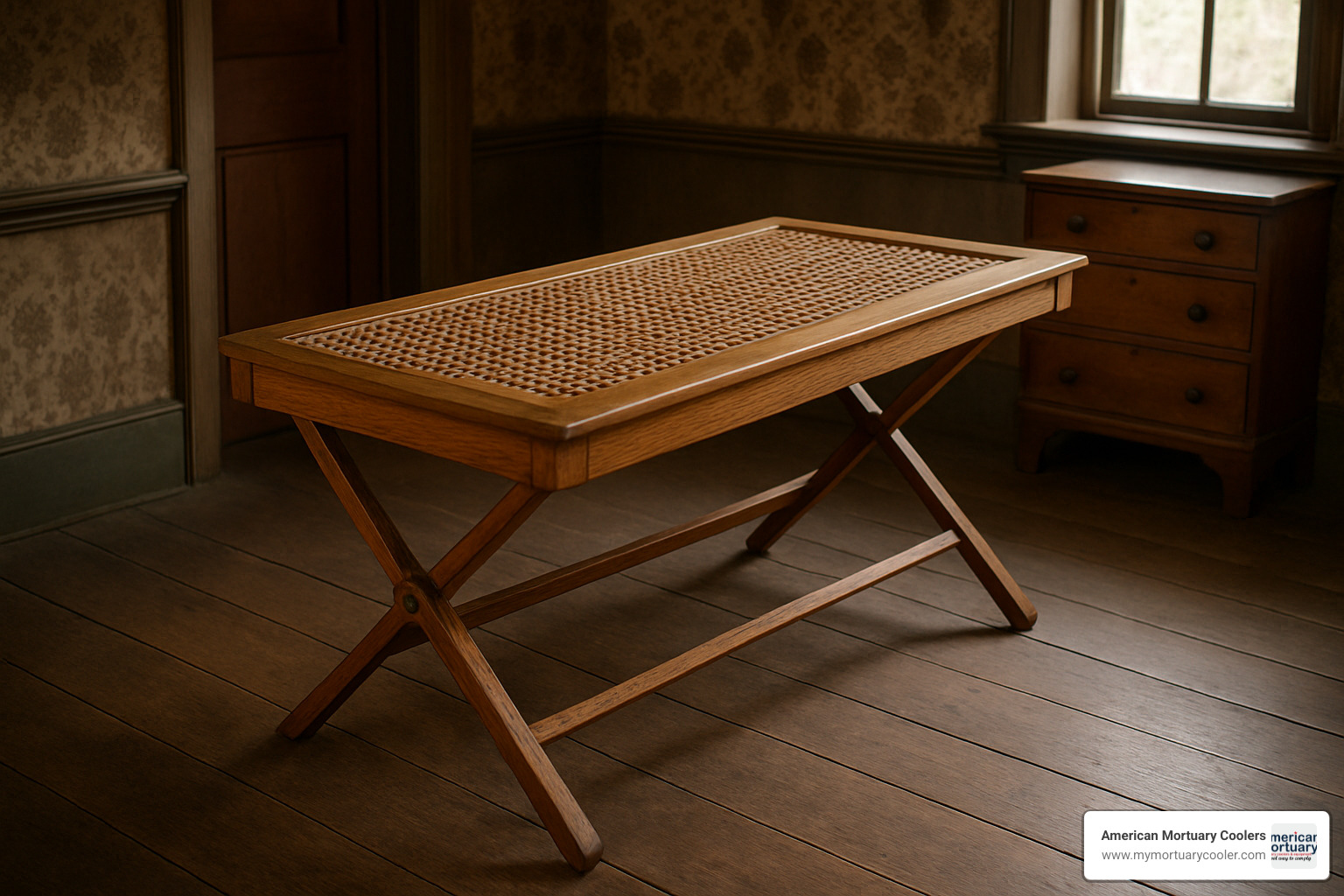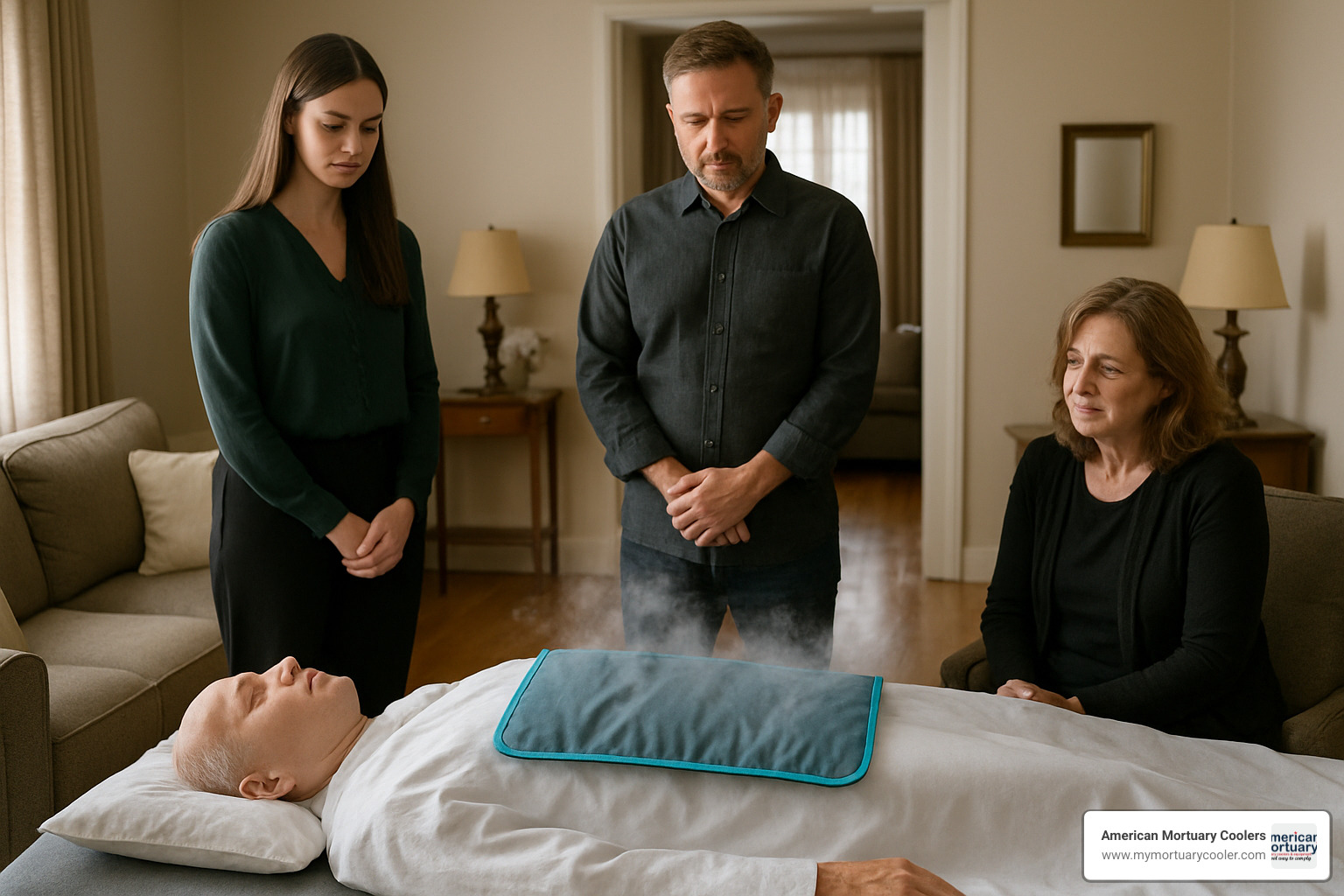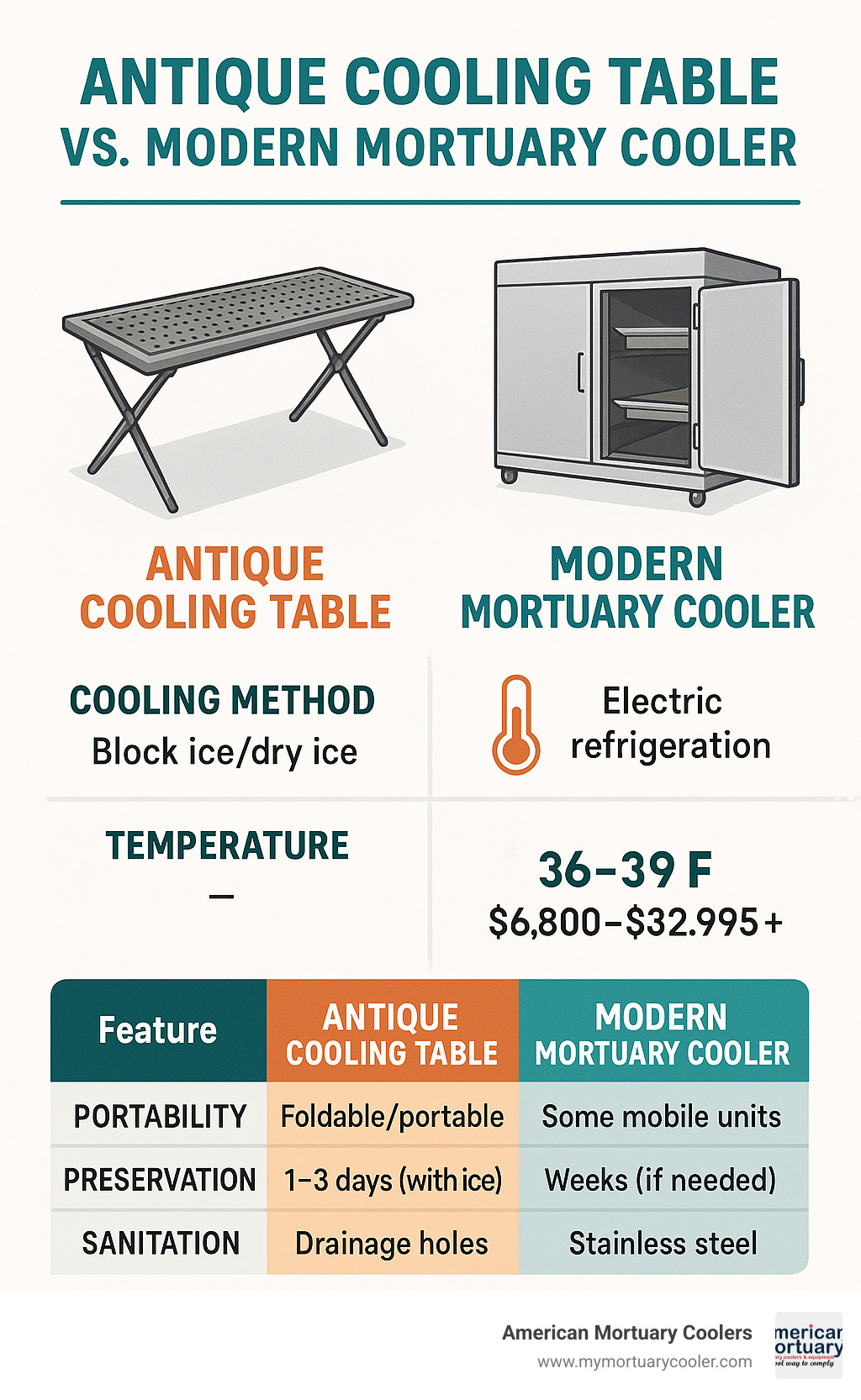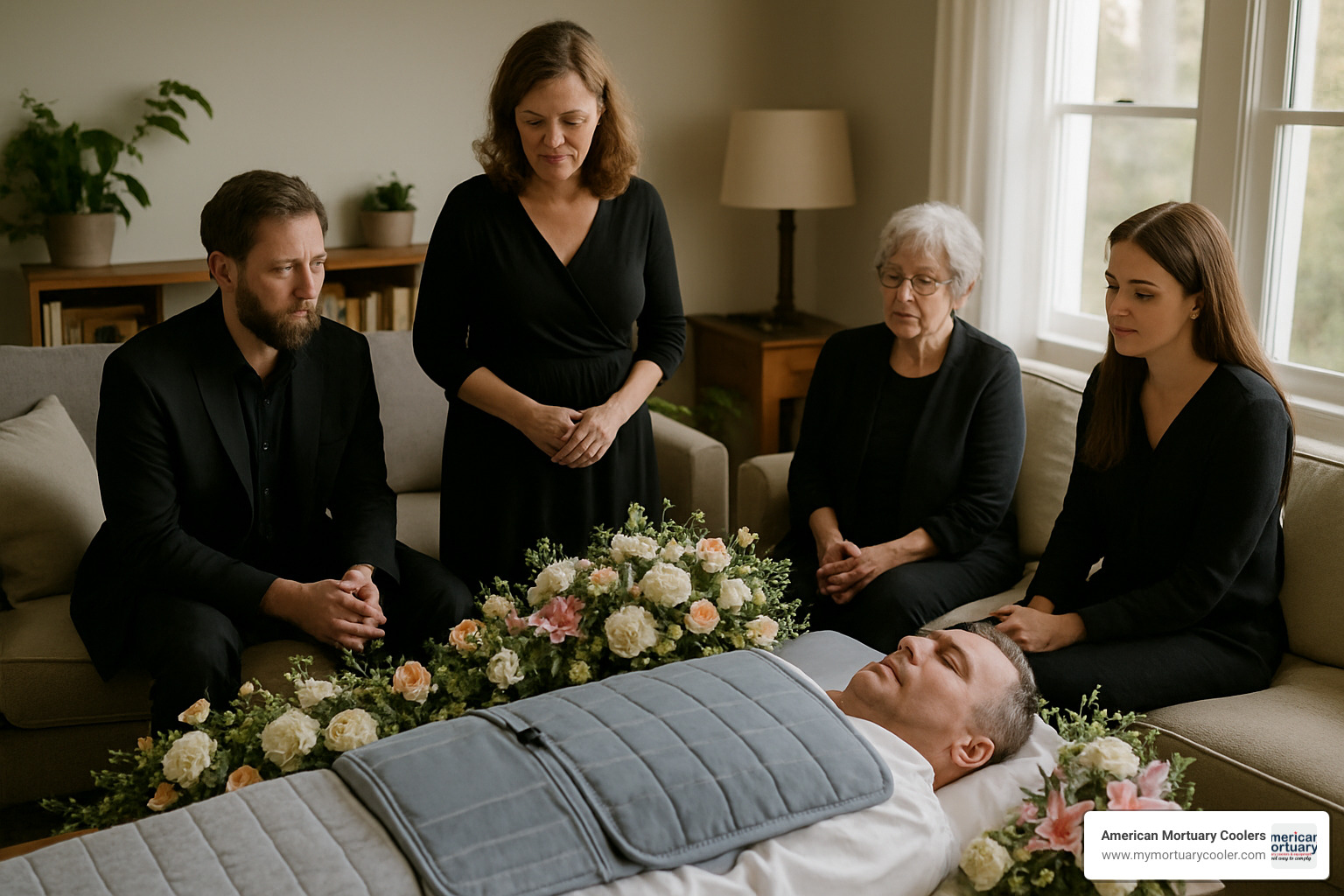Understanding the History and Purpose of Cooling Tables
A cooling table funeral was a common practice in the 19th and early 20th centuries before modern refrigeration and embalming became widespread.
What is a cooling table?
- A wooden platform with perforations or cane latticework
- Used to temporarily store and preserve a body before burial
- Typically placed in the home's parlor (later renamed "living room")
- Ice was positioned beneath the table to slow decomposition
- Also served as a display platform for viewing the deceased
Before the advent of modern funeral homes and refrigeration, families needed practical ways to preserve loved ones after death. The cooling table (also called a cooling board) served this crucial purpose, allowing families to keep the body at home for 1-3 days while funeral arrangements were made.
These tables were ingeniously designed with perforations that allowed cold air to circulate and bodily fluids to drain. A typical cooling table from the late 1800s measured approximately 75 inches long by 22 inches wide by 20 inches tall, and many could be folded for transport by traveling morticians who made house calls.
In Appalachian regions, it was common practice to store bodies on cooling boards in barns during winter months until the ground thawed enough for burial. Some cooling tables featured specialized designs, including child-sized versions and those with adjustable headrests for better viewing.
I'm Mortuary Cooler, a national supplier of mortuary refrigeration equipment with extensive knowledge of both historical and modern cooling table funeral practices. My experience spans decades in the funeral industry, helping funeral directors transition from traditional cooling table funeral methods to modern refrigeration solutions while honoring historical practices.

Cooling table funeral definitions:
Cooling Table Funeral: Definition and Historical Role
The cooling table funeral represents one of America's most practical and intimate death traditions. Before the days of modern funeral homes and refrigeration, these specialized tables served as the centerpiece of home-based death care, allowing families precious time with their loved ones before burial.
A cooling table wasn't just any surface—it was thoughtfully engineered for the solemn task at hand. These tables featured perforated wooden tops or cane latticework that allowed air to circulate around the body while providing drainage for natural fluids. Raised on sturdy legs, they created space underneath for ice placement, the period's only reliable preservation method.
Many cooling tables featured folding designs for easy transport, as undertakers often traveled from home to home with their equipment. The most touching variations included smaller boards crafted specifically for children, a sad necessity in an era of high infant mortality.
Origins of the Cooling Table Funeral Custom
Death in 19th century America was overwhelmingly a household event. When someone passed away, they typically did so in their own bed, surrounded by family. With no funeral parlor to call and no refrigeration available, families needed immediate solutions.
The Civil War significantly influenced American death practices, introducing embalming to a wider audience as preserved bodies of soldiers were shipped home for burial. However, for decades following, most ordinary families couldn't access or afford professional embalming. Instead, the cooling table funeral became their practical alternative.
Early undertakers—often furniture makers, cabinet builders, or simply community members who had taken on the role—would arrive at homes with folding cooling boards tucked under their arms. In remote areas and harsh winters, practicality sometimes required extraordinary measures. Families in Appalachia and other cold regions would store their deceased on cooling boards in barns or outbuildings until spring thaws made burial possible.
Design Features & Materials
These tables reflected both functionality and craftsmanship that honored their solemn purpose:
Oak frames provided the strength and dignity befitting their task. This wood wasn't chosen randomly—it resisted warping from moisture, could be thoroughly cleaned between uses, and remained available to craftsmen across the country.
The defining feature of most cooling tables was their cane latticework or perforated tops. This ingenious design promoted cold air circulation while allowing bodily fluids to drain discreetly into basins placed below—a practical necessity before embalming became commonplace.
Portability remained essential for early funeral professionals. Handles, folding legs, and lightweight construction allowed undertakers to transport their equipment between homes. Some even featured adjustable headrests that liftd the deceased's head slightly, creating a more natural appearance during viewing.

While primarily utilitarian, many cooling tables weren't without aesthetic touches. Brass fittings, turned legs, and occasionally inlaid wood showed the care craftsmen put into these specialized funeral items. After all, they served as the final resting place for loved ones during those crucial days of home viewing and mourning.
The cooling table funeral tradition speaks to a time when death care remained firmly in family hands—practical, personal, and present within the home itself.
Practical Use: From Ice Blocks to Dry Ice
Before modern refrigeration, the cooling table funeral was a practical necessity that required some serious planning. Families had to be resourceful and thoughtful during what was already a difficult time.
How Did the Cooling Table Funeral Work?
When a loved one passed, the clock started ticking. Families needed to preserve the body long enough for relatives to travel, for funeral arrangements to be made, and for proper goodbyes to be said.
Ice was the miracle worker of its day. Delivered in blocks from ice houses or harvested from winter ponds and stored in sawdust throughout the year, ice was precious cargo for a home funeral. A typical body needed about 15 pounds of ice per day – quite a substantial amount when you consider multi-day vigils were common.
The setup was straightforward but effective. The cooling table funeral would take place in the family parlor (what we now call the living room), with the cooling board positioned prominently. Ice would be carefully arranged beneath the perforated or caned top, allowing cold air to circulate around the body.
One of the cleverer aspects of these tables was their drainage system. Small holes allowed fluids to drip into receptacles placed below, keeping everything as clean and dignified as possible during the viewing.
In the Appalachian mountains, communities developed their own unique approach to winter deaths. When the ground was frozen solid, families would place the deceased on cooling boards in barns until spring thaws made burial possible. This practical solution gave rise to the somber saying, "put the corpse in the barn till spring."
Cooling Table Funeral Procedures Step-by-Step
The process of preparing a body for a cooling table funeral was intimate and personal, often involving family members and close neighbors.
First came the washing and dressing of the body. This tender act was usually performed by women of the family or community who had experience with this sacred task. A waterproof liner or tarpaulin would be placed on the table to manage fluids.
Timing was crucial. Families needed to position the body before rigor mortis set in, gently massaging limbs to place them in a peaceful, natural position. Sometimes they would wait 12-48 hours for the stiffness to pass if they couldn't prepare the body immediately.
Insulation was key to maintaining cold. A quilt or heavy blanket would be draped over and around the body, helping to retain the cooling effect from the ice below. For longer vigils, multiple layers might be used.
The cooling materials themselves evolved over time:
- Historically: Block ice placed beneath the board was standard practice
- Today's home funerals: Dry ice (CO₂) or polymer refrigerant sheets (Techni-ice) offer safer, more manageable alternatives for modern home funerals

About 15 pounds of dry ice per day is typically needed for effective cooling beyond 24 hours. Safety is important – always use gloves when handling dry ice and ensure good ventilation in the room to prevent CO₂ buildup.
The body required regular attention. Family members would check cooling materials every 8-12 hours, replacing ice or refrigerant sheets as needed. They'd adjust based on the room temperature and the size of the person.
Throughout this process, the face and hands remained visible for visitors, creating a dignified presentation for those coming to pay their respects. Different cultural and religious traditions were honored in how the body was handled and presented.
Cultural Meanings & Music References
The cooling table funeral wasn't just practical – it was deeply woven into the cultural fabric of American life and death.
Blues music captured the raw emotion of this ritual. Son House's haunting "Death Letter" includes the line "I went to the funeral, Lord, and they put him on a cooling board," while other musicians sang "Cooling Board Blues." These references weren't just descriptive – they captured the finality and reality of death in a way everyone understood.
Our language itself was shaped by these practices. After the devastating influenza epidemic, many families began calling their parlors "living rooms" instead, trying to distance themselves from the room's association with death and cooling tables.
Even Abraham Lincoln's body was laid on a cooling board before his funeral, as documented by Benjamin B. French – a testament to how universal this practice was, from the humblest homes to the highest office in the land.
These cooling table funeral traditions, while practical in nature, provided something we still seek today: time to gather, mourn, and say proper goodbyes to those we've lost. They remind us that caring for our dead has always been a deeply human act, no matter what technologies we have at our disposal.
From Cooling Boards to Modern Mortuary Refrigeration
The journey from the simple wooden cooling table funeral practices of yesteryear to today's advanced refrigeration technology tells a fascinating story of how we've transformed the care of our departed loved ones.
As electricity lit up American homes in the early 20th century, those old oak cooling boards gradually made their way into attics and museums. In their place came new innovations that forever changed funeral practices:
Walk-in mortuary coolers now maintain perfect temperatures between 36°F and 39°F—a far cry from melting ice blocks that needed constant replacement. These coolers provide consistent cooling that dramatically slows decomposition while maintaining dignity and hygiene.
Self-contained body boxes offer flexibility for smaller funeral homes or during times when multiple bodies need storage. These portable units plug in anywhere, bringing modern refrigeration to even remote locations.
While embalming became increasingly common after the Civil War (when it was used to preserve soldiers' bodies for the long journey home), it's worth noting that contrary to popular belief, it's not legally required for most deaths in the United States.
Antique Cooling Tables vs. Modern Mortuary Coolers
| Feature | Antique Cooling Table | Modern Mortuary Cooler |
|---|---|---|
| Cooling method | Block ice/dry ice | Electric refrigeration (36–39°F) |
| Capacity | 1 person | 1–8+ persons per unit |
| Portability | Foldable/portable (some models) | Some units mobile, others stationary |
| Preservation time | 1–3 days (with ice) | Weeks (if needed) |
| Sanitation | Basic, drainage holes | Stainless steel, easy cleaning |
| Cost (2024) | $2,000–$6,000 (antique value) | $6,800–$32,995+ (new, by capacity) |
| Typical use today | Collectible, rare home funerals | Standard in funeral homes/hospitals |

For those interested in learning more, we've published detailed guides on The Ultimate Embalming Table Roundup for Funeral Professionals and Antique Cooling Boards 101.
Home Funeral Best Practices Today
While most Americans now say goodbye to loved ones in funeral homes, there's a heartening revival of interest in home-based vigils. This renaissance is especially strong among those drawn to green burial practices and families seeking more intimate, personalized farewells.
Modern home funeral practitioners have adapted cooling methods for contemporary use. Dry ice remains popular, with about 15 pounds needed daily, carefully placed in cooling blankets or beneath the body. Proper ventilation is essential, as is wearing gloves to prevent burns.
Polymer refrigerant sheets like Techni-ice offer a reusable alternative—simply soak, freeze, and place around the body for 3-4 hours of cooling before needing reactivation. For very brief periods, some families even use gel packs or frozen vegetables when other options aren't immediately available.
Don't underestimate your home's air conditioning either. Keeping room temperature below 65°F significantly slows decomposition during a brief home vigil.
If you're considering a home funeral, remember these important safety tips: always handle dry ice with gloves to prevent freezer burns, ensure good ventilation to prevent carbon dioxide buildup, and remove all cooling materials before cremation or burial. Most importantly, check your state's laws—many require burial or refrigeration within 24-48 hours of death.

The National Home Funeral Alliance offers comprehensive guides to body care and cooling for those seeking more information.
Cooling Table Funeral Revival in Green Burials
As our society reconsiders its relationship with death and the environment, the green and natural burial movements have breathed new life into home funeral traditions. Many families now choose minimal-intervention approaches that would feel familiar to our ancestors:
DIY vigils often feature simple tables with modern cooling materials rather than antique cooling boards. The spirit remains the same—caring for our own in the comfort of home.
Eco-friendly cooling options have evolved too. Biodegradable cooling blankets made with plant-based sleeves for dry ice offer effective cooling without environmental harm, as described in this guide to dry ice cooling blankets for home funerals.
The choice to avoid embalming chemicals while using natural refrigeration methods aligns perfectly with green burial values. This return to simpler practices connects us with historical traditions while honoring our modern environmental consciousness.
While American Mortuary Coolers specializes in modern refrigeration solutions, other companies like Frigid Fluid, Mortech Manufacturing, and Mopec also offer various mortuary cooling products. Each company has its own approach to mortuary refrigeration technology, with some focusing on portable solutions while others specialize in larger walk-in units or specialized features.
At American Mortuary Coolers, we respect both the rich history of cooling table funerals and the innovative future of mortuary refrigeration. Our Tennessee-crafted coolers continue this evolution with durable, custom-built solutions that we deliver directly to funeral homes across the contiguous United States.
Frequently Asked Questions about Cooling Tables
Why were cooling tables essential before modern refrigeration?
Before refrigeration transformed funeral practices, cooling table funerals were absolutely necessary for practical reasons. When someone passed away at home (as most people did), families faced an immediate challenge: how to preserve their loved one's body while relatives traveled from afar and burial arrangements were made.
The humble cooling table offered an neat solution. By placing ice beneath the perforated surface, families could slow decomposition just enough to allow for a proper period of mourning and visitation—typically 1-3 days. This wasn't just about preservation; it created precious time for communities to gather, pay respects, and process their grief together.
Without these tables, families would have faced the heartbreaking reality of immediate burial, often before all loved ones could arrive to say goodbye. In a world without funeral homes or embalming services in every town, the cooling table funeral created a bridge between death and burial that honored both practical needs and emotional ones.
Are cooling tables still legal to use in a home funeral today?
Yes, most states fully support your right to care for your deceased loved ones at home, including the use of cooling methods. The tradition of the cooling table funeral has found new life in today's home funeral movement, though with modern adaptations like dry ice instead of block ice.
That said, each state maintains specific regulations about death care. Most require filing a death certificate within 72 hours and have rules about how long a body can remain unrefrigerated or unembalmed (typically 24-48 hours). Some states require a funeral director's involvement for certain steps, while others allow families complete autonomy.
If you're considering a home funeral with cooling methods, I recommend connecting with your local home funeral alliance or checking with county health authorities. They can guide you through the requirements specific to your location, ensuring your home funeral honors both your loved one and the law.
How much is an antique cooling table worth to collectors?
Original cooling tables have become fascinating artifacts that connect us to how our ancestors handled death. Well-preserved antique cooling tables typically fetch between $2,000 and $6,000 in today's collector market, though exceptional pieces with documented history or unique craftsmanship can command even higher prices.
Several factors influence a cooling table's value: original cane latticework in good condition, functioning folding mechanisms, documented provenance (especially if connected to a notable person or historical event), and distinctive design elements like carved decorations or brass fittings.
These pieces appeal to diverse collectors—from those focused on Victorian mourning customs to collectors of early American furniture or medical antiques. Museums dedicated to funeral history particularly prize these artifacts as they help tell the story of how American death care evolved from family-centered practices to the professional funeral industry we know today.
For most families who find an old cooling board in their attic or barn, the historical and sentimental value often exceeds the monetary worth, offering a tangible connection to how their ancestors honored their dead with dignity and care before modern funeral practices took hold.
Conclusion
The journey of the cooling table funeral is more than just a historical footnote—it's a window into how Americans have honored their dead across generations. From those simple wooden boards cooled by blocks of ice to today's advanced refrigeration systems, the fundamental purpose remains beautifully consistent: preserving dignity and giving families precious time to gather, grieve, and say their goodbyes.
At American Mortuary Coolers, we see ourselves as caretakers of this meaningful tradition. While the technology has evolved dramatically, the heart of what we do connects directly to those early cooling tables. Our modern, energy-efficient coolers may look different from their wooden ancestors, but they serve the same essential human need—creating space for proper farewells.
Our custom-designed mortuary coolers are built with the same care and attention to detail that craftsmen once put into those antique cooling boards. Each unit is constructed to last, meeting all federal standards while adapting perfectly to your facility's unique needs and workflow. And just as traveling undertakers once brought cooling tables to homes across America, we deliver our solutions nationwide to all 48 contiguous states.

Whether you're a funeral director looking for reliable equipment, a home funeral advocate interested in both traditional and modern approaches, or simply someone fascinated by this aspect of American history, understanding the evolution from ice-chilled tables to modern mortuary coolers deepens our appreciation for these essential rituals. The ways we care for our dead reflect how we care for each other—with respect, dignity and love.
If you're seeking modern solutions that honor tradition while embracing innovation, we invite you to explore our full line of American Mortuary Coolers – nationwide custom solutions. Our team understands both the technical requirements and the emotional significance of proper care for the deceased.
Further reading:
- Exploring the Function and Design of Antique Cooling Tables
- Antique Cooling Boards 101
- Dry Ice Cooling Blanket for Home Funerals
- NHFA Body Care & Cooling Guide
- The Ultimate Embalming Table Roundup for Funeral Professionals
American Mortuary Coolers—preserving dignity, honoring tradition, and keeping cool since the 19th century (well, almost).


















